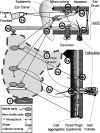Pseudomonas aeruginosa dose response and bathing water infection
- PMID: 24229610
- PMCID: PMC9151134
- DOI: 10.1017/S0950268813002690
Pseudomonas aeruginosa dose response and bathing water infection
Abstract
Pseudomonas aeruginosa is the opportunistic pathogen mostly implicated in folliculitis and acute otitis externa in pools and hot tubs. Nevertheless, infection risks remain poorly quantified. This paper reviews disease aetiologies and bacterial skin colonization science to advance dose-response theory development. Three model forms are identified for predicting disease likelihood from pathogen density. Two are based on Furumoto & Mickey's exponential 'single-hit' model and predict infection likelihood and severity (lesions/m2), respectively. 'Third-generation', mechanistic, dose-response algorithm development is additionally scoped. The proposed formulation integrates dispersion, epidermal interaction, and follicle invasion. The review also details uncertainties needing consideration which pertain to water quality, outbreaks, exposure time, infection sites, biofilms, cerumen, environmental factors (e.g. skin saturation, hydrodynamics), and whether P. aeruginosa is endogenous or exogenous. The review's findings are used to propose a conceptual infection model and identify research priorities including pool dose-response modelling, epidermis ecology and infection likelihood-based hygiene management.
Figures
Similar articles
-
Dose-response algorithms for water-borne Pseudomonas aeruginosa folliculitis.Epidemiol Infect. 2015 May;143(7):1524-37. doi: 10.1017/S0950268814002532. Epub 2014 Oct 2. Epidemiol Infect. 2015. PMID: 25275553 Free PMC article.
-
Risk assessment of Pseudomonas aeruginosa in water.Rev Environ Contam Toxicol. 2009;201:71-115. doi: 10.1007/978-1-4419-0032-6_3. Rev Environ Contam Toxicol. 2009. PMID: 19484589 Review.
-
Pseudomonas dermatitis/folliculitis associated with pools and hot tubs--Colorado and Maine, 1999-2000.MMWR Morb Mortal Wkly Rep. 2000 Dec 8;49(48):1087-91. MMWR Morb Mortal Wkly Rep. 2000. PMID: 11130858
-
From the Centers for Disease Control and Prevention. Pseudomonas dermatitis/folliculitis associated with pools and hot tubs--Colorado and Maine, 1999-2000.JAMA. 2001 Jan 10;285(2):157-8. JAMA. 2001. PMID: 11236748 No abstract available.
-
[Pseudomonas aeruginosa in dermatology].Ann Dermatol Venereol. 2017 Nov;144(11):666-675. doi: 10.1016/j.annder.2017.06.015. Epub 2017 Aug 2. Ann Dermatol Venereol. 2017. PMID: 28778416 Review. French.
Cited by
-
The impact of lifestyle upon the probability of late bacterial infection after soft-tissue filler augmentation.Infect Drug Resist. 2019 Apr 23;12:855-863. doi: 10.2147/IDR.S200357. eCollection 2019. Infect Drug Resist. 2019. PMID: 31118696 Free PMC article.
-
Pseudomonas aeruginosa in Swimming Pool Water: Evidences and Perspectives for a New Control Strategy.Int J Environ Res Public Health. 2016 Sep 15;13(9):919. doi: 10.3390/ijerph13090919. Int J Environ Res Public Health. 2016. PMID: 27649225 Free PMC article.
-
Dose-response algorithms for water-borne Pseudomonas aeruginosa folliculitis.Epidemiol Infect. 2015 May;143(7):1524-37. doi: 10.1017/S0950268814002532. Epub 2014 Oct 2. Epidemiol Infect. 2015. PMID: 25275553 Free PMC article.
-
Faecal Indicator Bacteria and Pseudomonas aeruginosa in Marine Coastal Waters: Is there a Relationship?Pathogens. 2019 Dec 21;9(1):13. doi: 10.3390/pathogens9010013. Pathogens. 2019. PMID: 31877730 Free PMC article.
-
Quantitative Microbial Risk Assessment and Opportunist Waterborne Infections⁻Are There Too Many Gaps to Fill?Int J Environ Res Public Health. 2018 Jun 1;15(6):1150. doi: 10.3390/ijerph15061150. Int J Environ Res Public Health. 2018. PMID: 29865180 Free PMC article.
References
-
- Mena KD, Gerba CP. Risk assessment of Pseudomonas aeruginosa in water. In: Whitacre DM, ed. Reviews of Environmental Contamination and Toxicology: Springer; USA, 2009: 71–115. - PubMed
-
- Rice SA, et al. A risk assessment of Pseudomonas aeruginosa in swimming pools: a review. Journal of Water and Health 2012; 10: 181–196. - PubMed
-
- Jacobson J. Pool-associated Pseudomonas aeruginosa dermatitis and other bathing-associated infections. Infection Control 1985; 6: 398–401. - PubMed
-
- Maniatis AN, et al. Pseudomonas aeruginosa folliculitis due to Non-O:11 serogroups: acquisition through use of contaminated synthetic sponges. Clinical Infectious Diseases 1995; 21: 437–439. - PubMed
Publication types
MeSH terms
LinkOut - more resources
Full Text Sources
Other Literature Sources



